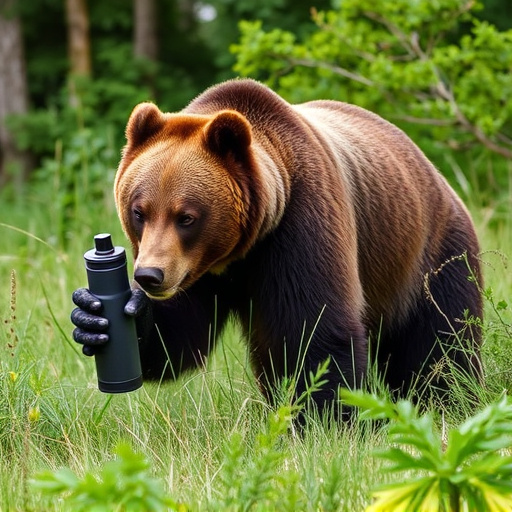Understanding bear behavior is key to hiking safety. To minimize risks, maintain distance, watch for signs, and make your presence known. If encountering a bear, stay calm, back away slowly, and use bear spray as a last resort. Regularly inspect canisters (2-3 years) for expiration, damage, or corrosion. Keep a spare in your backpack for remote areas. Before venturing into bear country, check equipment maintenance and replacement timing based on usage and expiration dates.
Hiking through scenic landscapes means embracing nature’s wonders—but also preparing for potential risks. When venturing into bear country, ensuring your safety becomes paramount. This guide equips hikers with essential knowledge on understanding bear behavior and selecting the right bear spray. Learn the art of inspection and testing to ensure your equipment is ready for any encounter. Discover key signs and recommendations on when to replace your bear spray canister, as proper maintenance could mean the difference between a safe hike and an unfortunate encounter.
- Understanding Bear Behavior in Hiking Areas
- Choosing the Right Bear Spray for Your Needs
- Inspecting and Testing Before Each Hike
- When to Replace: Key Signs and Recommendations
Understanding Bear Behavior in Hiking Areas
Understanding bear behavior is an essential aspect of hiking safety, especially in areas known for their resident bears. These majestic creatures have complex habits and can be unpredictable, so it’s crucial to know when and how to interact with them. In general, bears prefer to avoid humans, but they may become defensive if they feel threatened or surprised, especially when protecting their cubs or food sources.
When hiking in bear country, maintaining a safe distance is vital. Keep an eye out for any signs of bears, such as tracks or droppings, and make your presence known by talking softly and making noise with sticks or bells to avoid surprising them. If you encounter a bear, remain calm, back away slowly, and never turn your back. In the event that a bear charges, use your bear spray as a last resort, targeting the bear’s face and eyes. Regularly check the expiration date of your bear spray canister, including when to replace bear spray, to ensure its effectiveness during your hike.
Choosing the Right Bear Spray for Your Needs
When selecting bear spray, consider your specific hiking needs and environment. Factors like terrain, local bear behavior, and personal preferences influence the type and quantity of pepper spray you should carry. For instance, if you frequently hike in areas known for aggressive black bears, opt for a can with a higher concentration of capsaicin—the active ingredient in bear spray—and a longer range to provide more protection.
Regularly inspect your bear spray canister to determine when to replace it. Bear spray expiration dates vary, but generally, they last 2–3 years. Check the manufacturer’s instructions and look for signs of wear, corrosion, or leakage. Always keep a spare canister in your backpack in case you need to replace it during your hike, especially if you’re venturing into remote areas where access to supplies might be limited.
Inspecting and Testing Before Each Hike
Before setting out on any hike in bear country, it’s crucial to inspect and test your safety equipment, especially your bear spray canister. Regular maintenance ensures that your tools are in optimal condition when you need them most. Check for any signs of damage or corrosion on the canister itself and the nozzle. Ensure the seal is intact and the trigger is functioning smoothly. It’s also essential to know when to replace your bear spray. Most canisters have a use-by date, and their effectiveness decreases over time. Regular testing will help you gauge its potency, and it’s recommended to replace it if the spray pattern has changed or if it fails to deploy during practice tests.
When to Replace: Key Signs and Recommendations
Bear spray is a vital component of your hiking safety kit in bear country, but it’s crucial to know when to replace it. Understanding the key signs and following recommended guidelines will ensure its effectiveness during your outdoor adventures. One clear indicator that your canister should be replaced is if it has expired or passed its manufacturer-suggested date. Bear spray canisters typically have a shelf life of around 3 to 5 years, depending on the brand and storage conditions. Physical inspection is also essential; check for any signs of damage, corrosion, or leakage. If the nozzle appears blocked or the canister feels lighter than expected due to air leaks, it’s time for a replacement.
Additionally, bear spray performance degrades over time due to ingredient potency and chemical stability. Even if there are no visible damages, consider replacing your canister after 2-3 years of regular use or sooner if you’ve used more than half the content during hikes in areas known for aggressive bears. Following these recommendations will ensure that when a bear encounter occurs, your bear spray is ready to deter an attack and keep you safe.
When venturing into bear country, proper preparation is key. By understanding local bear behavior, selecting the appropriate bear spray, and regularly inspecting your equipment, hikers can significantly reduce potential risks. Remember, knowing when to replace your bear spray canister is vital for its effectiveness. Regular testing and observing signs of wear ensure you’re always prepared for any encounters with these majestic yet potentially dangerous animals. Stay safe and respect the wilderness!
